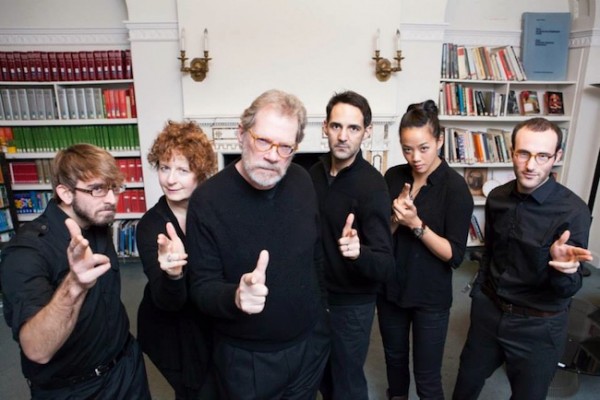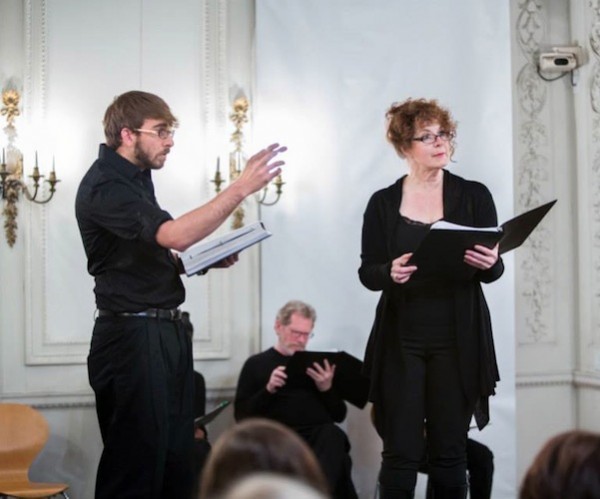Theater Review: “The Golden Dragon” — A Satire With Bite about International Cuisine
In his satire “The Golden Dragon,” Roland Schimmelpfennig holds his funhouse mirror up to “theater-people”: be they artists, audience, teachers, or students.
The Golden Dragon by Roland Schimmelpfennig. Translated by David Tushingham. Staged reading directed by Guy Ben-Aharon. Presented by German Stage at the Goethe-Institut, Boston, MA on December 8.
By Ian Thal
In the crowded kitchen of The Golden Dragon, a Thai-Chinese-Vietnamese fast food restaurant, five cooks rattle off menu items and ingredients at a machine gun pace. Meanwhile, on the second floor, a man in striped shirt is drinking himself into a stupor because his wife is leaving him for another man. In the attic of the same building a young couple suddenly must deal with the fact that a child is on its way. Hans, the proprietor of the shop next door to the Golden Dragon, orders the same carryout every day, while back at the Golden Dragon, two stewardesses, Inge and Eva, home after an 18 hour intercontinental flight, have a meal before returning to their flat in the same building. Elsewhere, a dancing cricket asks an ant for shelter from the winter cold.
Though director Guy Ben-Aharon often focuses on playwrights that are not well-known to Boston-area theater-goers, Roland Schimmelpfennig has a track record here beyond the New England premiere of The Golden Dragon at Boston’s Goethe Institut. Chelsea’s Apollinaire Theatre Company has staged Schimmelpfennig’s Arabian Night and will present the American premiere of his Peggy Pickit Sees the Face of God this February.
One of the cooks, whom the others call “The Boy”, is working despite the excruciating pain of an infected tooth. As workers from outside the E.U. in the cosmopolitan new Europe, the paid help are neither protected by a social safety net nor (much like U.S. restaurant workers who are neither entitled to the Federal minimum wage nor sick days) can they afford to take the day off to see a dentist. The only solution for the cooks, agitated by their young colleague’s cries of pain, is to perform the extraction themselves. The tooth, once freed from the cook’s gums, proceeds to have its own culinary adventures.
A subversive retelling of Aesop’s fable “The Ant and the Grasshopper” serves as another major storyline in the play. The original parable contrasted the industrious, hard-working ant, who stores provisions for the winter, with the frivolous cricket, who sings and dances throughout the summer. The yarn is often seen as an inditement of the artistic life. Schimmelpfennig uses the fable as a way to explore the sins of trafficking young women in the global sex industry: The cricket is far from her home, hidden away in a chamber in the ant’s burrow, unsure if winter is over. The thrifty ant is no longer simply the master of a well-ordered household, but a rapacious capitalist for whom human dignity is just another product to be bought or sold.
Schimmelpfennig’s genre-deconstruction is not without precedent: Indeed, the western art tradition often represents the grasshopper or cricket as a vulnerable woman (in Romance languages, the word for “grasshopper” is feminine). Sometimes she is an itinerant musician as in Gustave Doré’s The Ant and the Grasshopper or other times naked and eroticized, such as in Jules-Joseph Lefebvre’s The Grasshopper, in which she invites the gaze of the viewer upon her, even as she stands nude amongst the crinkled autumn leaves.
There’s nothing surprising in the revelation of how the cricket’s life intersects with the shopkeeper, the man in the striped shirt, the young man from the attic flat, and the man with the toothache. Still, Schimmelpfennig uses the chain of exploitation to show the heinousness of sexual exploitation without descending into hypocritical exploitation.
The stewardesses, on the other hand, are trafficked women of a different sort: ‘legitimately’ exoticized and commodified. One of the women has even mastered the art of self-objectification (as opposed to the abject-ification forced upon the cricket by the ant). She not only perceives herself as a Barbie™ made flesh, but has dubbed her lover “The Barbie-Fucker.” He enthusiastically embraces the moniker.
These above examples are only a sampling of the forms of alienation that Schimmelpfennig explores throughout the play. He also creates theatrical distance through his treatment of the cast members, which includes a man (Nael Nacer), a man over sixty (Patrick Shea), a woman over sixty (Paula Plum), a young man (Phil Tayler), and a young woman (Tiffany Chen). The performers play a wide assortment of characters: male and female, young and old, German and Asian. Early on the script describes the cooks as being Vietnamese though the “Asian man with toothache” is later identified as Chinese — perhaps as a poke in the eye for audience members who cannot tell the difference.
The script further incorporates alienation when the characters narrate their stage directions, vocalizing the smiles, the pauses, and the discovery of stray teeth. At first, the effect turns each character into a kind of solo storyteller, but increasingly the technique seems to scramble traditional western notions of identity, individuality, free will, and subjectivity.
Since its inception last year, the plays presented by German Stage have stood apart from the scripts Boston audiences generally see. One of the most important differences was that former wrestled with German history and what it means to be German in the twenty-first century. They addressed the contradiction between Germany’s Enlightenment traditions and imperialistic ambitions (as in the case of Goethe-Institut Boston Director Detlef Gericke-Schönhagen’s Voltaire & Frederick), the representation of the Third Reich in art (Theresia Walser’s Before the Storm), coming to terms with the tyranny of East Germany’s communist regime (Walser’s I am Just Like You, I like Apples). Most recently, the challenges of both reunification and that of Jews who continued to live in Germany after the Holocaust were explored (Marianna Salzmann’s Mameloschn).

The cast of “The Golden Dragon” at German Stage — with director Guy Ben-Aharon at the right. Phil Tayler, Paula Plum, Patrick Shea, Nael Nacer, Ting Ting Chen. Photo: Alena Kuzub
In contrast to these other plays, only a few clues, such as the names of the stewardesses and the shopkeeper, suggests that The Golden Dragon takes place in Germany: the fact that the unnamed river (presumingly the Elbe) flows through the city and out to the North Sea identifies the locale as city of Hamburg, where Schimmelpfennig serves as house author at the Deutsches Schauspielhaus. Otherwise, the story could occur in any major city in any western country in which “Asian” restaurants serve fast food to clientele whose thirst for the exotic does not extend far beyond knowing the differences between Thai, Chinese, and Vietnamese cuisine, let alone being able to distinguish between the accents of the people making the food. This is lampooned up by Ben-Aharon and his ensemble by having the cooks recite the menu items in a generic “Pan-East Asian” accent.
While this generic accent is an instance of theatrical “yellow-face,” the aim is not to perpetuate stereotypes of Thai, Chinese, nor Vietnamese people for cheap laughs. Schimmelpfennig is far too subversive for that. The more politically-correct dramatist might target the ignorant, culturally insensitive, mildly racist people who do not go to theater. No, Schimmelpfennig wants to hold his funhouse mirror up to “theater-people”: be they artists, audience, teachers, or students. His targets are people who perceive themselves as cosmopolitan, interested in new cultural experiences, and admirably sensitive to those of different backgrounds.
Amongst the people who often patronize places like The Golden Dragon is the politically correct westerner who gives little thought to how the countries and cuisines of East Asia have their unique characteristics and histories, whose understanding of the Asian continent may not include countries such as India, Pakistan, Afghanistan, Iran, Iraq, Turkey, Syria, and Israel, and who cannot grasp that a dish whose ingredients include “Vietnamese mushroom [and] Thai basil” is an example of cultural pastiche. Some do know better, but only care that a delicious dinner has been served. Indeed, as I write this, while visiting family in New York, I have engaged in culinary philistinism, enjoying Thai, Chinese, Japanese, and Vietnamese food in an “Asian fusion” restaurant — though every single person at the table knew the differences among the cultures.
Ironically, for a play that could conceivably be set in any of a number of Boston-area neighborhoods, this script is unlike any that is appearing on local stages. Perhaps we are a bit too polite (or afraid?) to see ourselves as we are.
Ian Thal is a performer and theatre educator specializing in mime, commedia dell’arte, and puppetry, and has been known to act on Boston area stages from time to time, sometimes with Teatro delle Maschere, and on occasion served on productions as a puppetry choreographer or dramaturg. He has performed his one-man show, Arlecchino Am Ravenous, in numerous venues in Massachusetts and Rhode Island, and is currently working on his second full length play; his first, though as-of-yet unproduced, was picketed by a Hamas supporter during a staged reading. Formally the community editor at The Jewish Advocate, he blogs irregularly at the unimaginatively entitled From The Journals of Ian Thal, and writes the “Nothing But Trouble” column for The Clyde Fitch Report.

